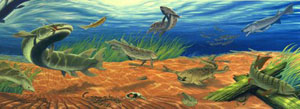The diversification of fish
When discussions turn to Devonian vertebrates, the first animals to come to mind are fish.
 (36 kb) Although it is true that tetrapods appeared at the very end of this time period, they were barely distinguishable from fish in anatomy and behaviour. It is thus reasonable to say that fish reigned during the Devonian, as dinosaurs reigned during the Mesozoic.
(36 kb) Although it is true that tetrapods appeared at the very end of this time period, they were barely distinguishable from fish in anatomy and behaviour. It is thus reasonable to say that fish reigned during the Devonian, as dinosaurs reigned during the Mesozoic.
The Devonian Period is famous for being the “Age of Fishes”, even though plants and invertebrates also experienced important evolutionary changes. Throughout the 57 million years of Devonian time, fish evolution was marked by extreme diversification and the appearance of many new types of fishes.
Devonian fish species are divided among two large groups, agnathans, an assorted group of jawless fishes, and gnathostomes, the jawed fishes.
The agnathans would only narrowly survive the great biological crisis at the end of the Devonian. Of the six known agnathan groups, four would perish. And of the two that remained, only a handful of species still live today, including lampreys and hagfish.
Gnathostomes experienced diverse fates. The last of the acanthodians disappeared after the Devonian, as did the last placoderms, despite being the predominant group until their demise. Conversely, three other groups were very successful. Chondrichthyans, comprising sharks and rays, prospered and are still present to this day. Many sarcopterygian subgroups appeared in the Devonian, one of which was the ancestor of the first tetrapods. The evolution from sarcopterygian to tetrapod was a remarkable evolutionary achievement: 27,000 tetrapod species still exist, a number that does not include all those that became extinct along the way. In stark contrast, only a dozen or so fish species, including coelacanths and lungfish, are among the surviving sarcopterygians.
Actinopterygians, ray-finned fishes, were undeniably an evolutionary success. With nearly 29,000 species currently living in fresh and marine waters around the world, they constitute the planet’s largest vertebrate group.

 (36 kb) Although it is true that tetrapods appeared at the very end of this time period, they were barely distinguishable from fish in anatomy and behaviour. It is thus reasonable to say that fish reigned during the Devonian, as dinosaurs reigned during the Mesozoic.
(36 kb) Although it is true that tetrapods appeared at the very end of this time period, they were barely distinguishable from fish in anatomy and behaviour. It is thus reasonable to say that fish reigned during the Devonian, as dinosaurs reigned during the Mesozoic.The Devonian Period is famous for being the “Age of Fishes”, even though plants and invertebrates also experienced important evolutionary changes. Throughout the 57 million years of Devonian time, fish evolution was marked by extreme diversification and the appearance of many new types of fishes.
Devonian fish species are divided among two large groups, agnathans, an assorted group of jawless fishes, and gnathostomes, the jawed fishes.
The agnathans would only narrowly survive the great biological crisis at the end of the Devonian. Of the six known agnathan groups, four would perish. And of the two that remained, only a handful of species still live today, including lampreys and hagfish.
Gnathostomes experienced diverse fates. The last of the acanthodians disappeared after the Devonian, as did the last placoderms, despite being the predominant group until their demise. Conversely, three other groups were very successful. Chondrichthyans, comprising sharks and rays, prospered and are still present to this day. Many sarcopterygian subgroups appeared in the Devonian, one of which was the ancestor of the first tetrapods. The evolution from sarcopterygian to tetrapod was a remarkable evolutionary achievement: 27,000 tetrapod species still exist, a number that does not include all those that became extinct along the way. In stark contrast, only a dozen or so fish species, including coelacanths and lungfish, are among the surviving sarcopterygians.
Actinopterygians, ray-finned fishes, were undeniably an evolutionary success. With nearly 29,000 species currently living in fresh and marine waters around the world, they constitute the planet’s largest vertebrate group.
Site map | Feedback | Links | Sources | Credits
The diversification of fish
<< Life in the sea | Toward the first tetrapods >>



